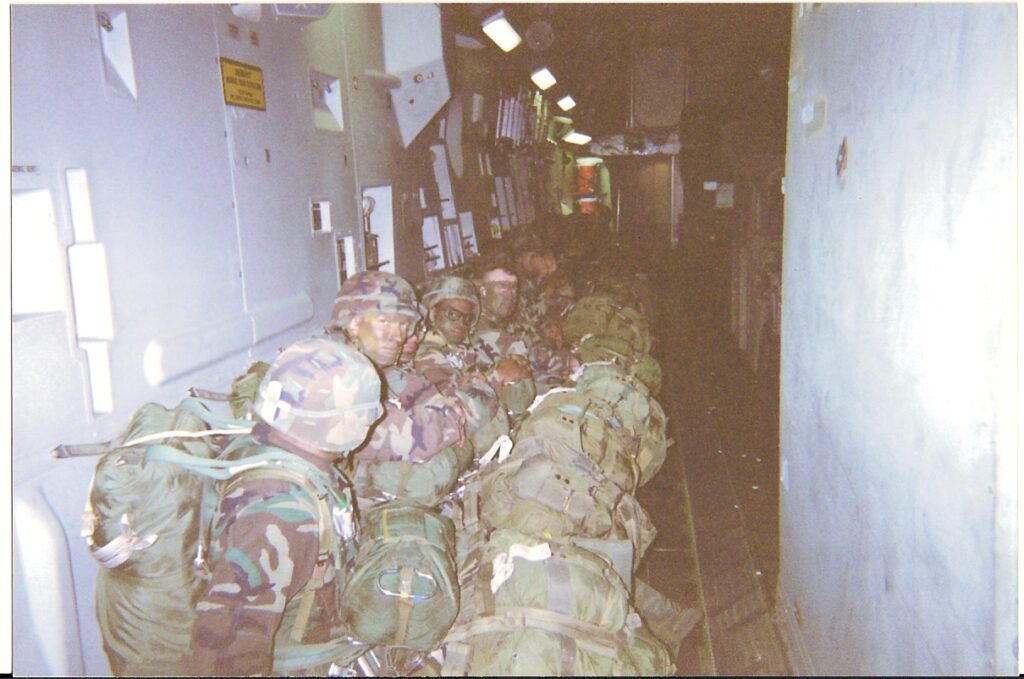Most Airborne Operations are conducted at night under darkness, almost 90 percent of the jumps. I enjoyed jumping at night because I could not see the ground or anything else. However, seeing the earth, roads, open fields, lakes, and other stuff was incredible.
On the one hand, jumping at night, I could focus on what I needed to do in order to get on the ground safely (not looking around); yet, it was an awesome sight to see all the other jumpers in the sky and watch my descent towards the ground during daylight hours.
When you jump out of the aircraft, you get a three to four-second free-fall before your parachute opens. Training jumps are 1,200 feet, and massive tactical combat jumps are 800 feet. Moreover, at 800 feet, there is no time to contemplate what to do, be scared, or have doubts about what to do in case of a parachute malfunction; you must follow procedures.
One night, on a training jump at a Drop zone in Fort Bragg, North Carolina, I was loaded with approximately 100 pounds of gear: my ALICE pack, rifle, load-bearing equipment, and helmet. Every paratrooper is loaded with massive amounts of equipment, and it sucks – there is no getting around the hardship of carrying the weight. This is why we must be in good physical condition. As a paratrooper, you hit the ground ready to fight – you need that equipment.
On this night, I was tired but ready to jump. We flew around for hours, and then the Jump-master team gave us the ten-minute warning, and everyone yelled, “Ten minutes!” Next, the Jump-masters told us to get ready and to “stand up.” Once everyone stood up, the Jump-masters told us to check our equipment. I checked my straps and equipment, ensuring nothing was twisted or caught on something inside the aircraft. My airborne buddy behind me checked my parachute to ensure everything looked good (that is, nothing was twisted and broken).
Once the equipment is checked and everything is ‘Okay,’ the Air Force Loadmasters open the doors to the aircraft. You can hear the roar of the engines, the smell of jet fuel, and the wind blowing loud; basically, you cannot hear yourself think (image driving down the highway at or about 75 miles an hour and you roll down the window, now magnify the sound times ten and that’s what it’s like when the doors are open in an airplane while in flight).
For the Jump-master team, everything is hand and arm signals.
With the doors open, the loadmasters gave the sign for the jump-masters to check the doors for any sharp objects or obstructions that could hurt and hinder a paratrooper from exiting the aircraft. The jump-master is standing at the aircraft door – hanging out of the plane, and looking for the drop zone. It is the craziest thing you ever want to see, but awesome.
Then, the jump-master gives the “1 minute,” time goes by, and then the “30-second” warning comes, and the jump-masters step away from the door and yell, “Standby.” The drop zone is coming into view.
The standby signal tells everyone that the green light is coming. For me, the Standby signal meant that this is going to happen, and there was no getting out of this Shit – I am going to jump from a perfectly good airplane.
The Green light came on, and everyone started walking toward the door, jumping out of the aircraft, and the closer I got to the door, the more my heart started to pump. Yet, when I got to the door, I was so heavy that I didn’t get a good jump (you are supposed to jump out and away from the aircraft); however, I didn’t, I fell out of the plane, and I could feel myself spinning in the air.
“Oh damn,” I thought! I am in trouble, this is not good, yet my parachute barely opened with twisted-up risers. It felt like I was being strangled because the parachute risers were wrapped and twisted around my neck. I thought about pulling my reserve parachute, but because I was spinning out of control, I needed to get those parachute risers free and untwisted.
After working on the procedures, I got the parachute risers free, my parachute fully deployed, and I could relax. I took a breath and realized I hadn’t released my ALICE pack. I immediately reached down to grab the quick-release cord – pulling the release cord, I hit the ground, HARD. I quickly realized that my legs were not broken. Oh wow, I should have broken my legs. I just had a 65-pound pack land on my legs, and my landing form was wrong. I laid on the ground with the quick release cord in my hand. I actually laughed.
I could walk away from that jump, yet, in the back of my mind, I knew that I had screwed up badly. I should have focused on existing the aircraft with a sense of purpose. Yet, it is complex with that much weight.
Throughout my time as a Paratrooper, I have had good friends whose parachutes had malfunctioned, or that had a bad exit, or something else went wrong (high winds on the drop zone). One friend was in a wheelchair for a year before he could walk again. Another good buddy of mine, his parachute collapsed 75 feet in the air, and because of his physical fitness level, he walked away from the jump. However, three months later, he heard a pop in his back and became paralyzed from his waist down. He did recover, but he still suffered from those injuries years later.
Some may see this as risky behavior and a tough job. It is, there is no doubt. Yet, everything is risky, life is risky, and I would rather die doing something exciting, challenging, essentially living life to the fullest.
Finish Strong.

